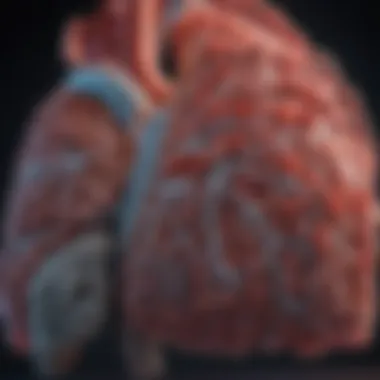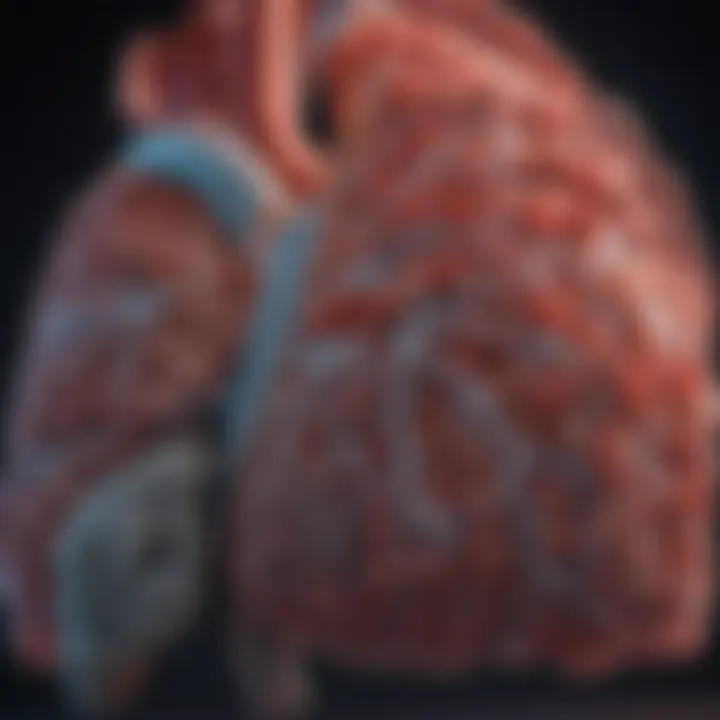Identifying High-Risk Populations for Lung Cancer


Overview of Research Topic
Brief Background and Context
Lung cancer is a significant public health challenge, known for its high mortality rate globally. The disease's complexity arises from an interplay of various risk factors that can predispose individuals to its development. These can be broadly categorized into demographic elements, environmental influences, genetic factors, and lifestyle choices. Understanding these categories enables researchers and healthcare providers to identify high-risk populations more effectively, facilitating timely interventions.
Importance in Current Scientific Landscape
In recent years, research into lung cancer risk factors has gained momentum. This is particularly critical in light of changing environmental conditions and lifestyle trends that may affect susceptibility. Identifying high-risk populations can help tailor public health strategies, ensuring resources are directed toward those most in need of preventive measures. Moreover, advancing knowledge in this area contributes to improving early detection rates through targeted screening programs.
Methodology
Research Design and Approach
This article employs a systematic review approach to assess existing literature on lung cancer risk factors. By gathering comprehensive data across diverse studies, the goal is to encapsulate the multifaceted nature of lung cancer risks.
Data Collection Techniques
Data collection involves analyzing peer-reviewed journals, population health surveys, and meta-analyses. Various databases like PubMed and Google Scholar provide rich sources of information. Special attention is paid to demographic data, environmental exposure records, and detailed lifestyle assessments. This meticulous collating of information aids in revealing patterns that signify higher lung cancer risks among certain groups.
Understanding lung cancer risk factors not only informs prevention strategies but also aids in crafting educational initiatives targeting at-risk populations.
Key Factors Influencing Risk
- Demographics: Age, sex, and race significantly influence lung cancer incidence and outcomes.
- Environmental Factors: Exposure to pollutants and carcinogens, particularly in occupational settings, can elevate lung cancer risk.
- Genetic Predispositions: Family history of lung cancer may point to genetic susceptibilities.
- Lifestyle Choices: Smoking remains the leading cause, but factors such as diet and physical activity also play a role.
Examining these factors in detail not only facilitates the identification of at-risk populations but also aids in shaping preventive healthcare policies and resource allocation.
Understanding Lung Cancer
Lung cancer presents a significant health concern globally, forming a primary cause of cancer-related deaths. Understanding lung cancer is essential to comprehend its implications for patients, healthcare providers, and society at large. This groundwork enables better screening strategies, targeted prevention, and refined treatment approaches. By exploring the nuances of lung cancer types, statistics, and incidence, we can identify high-risk populations and develop effective intervention strategies.
Definition and Types
Non-Small Cell Lung Cancer
Non-Small Cell Lung Cancer (NSCLC) is the most common type, accounting for nearly 85% of lung cancer cases. This category includes various histological subtypes such as adenocarcinoma, squamous cell carcinoma, and large cell carcinoma. One notable feature of NSCLC is its slower growth rate compared to Small Cell Lung Cancer (SCLC). This characteristic makes it pertinent for early detection efforts, as patients may present with symptoms later. The relatively slower progression provides a window for potential treatment interventions.
Benefits of understanding NSCLC lie in its responsiveness to targeted therapies. For instance, patients with specific genetic mutations can benefit significantly from targeted treatments, improving outcomes. However, challenges remain, particularly in advanced stages, where metastasis can complicate treatment options.
Small Cell Lung Cancer
Small Cell Lung Cancer accounts for approximately 15% of lung cancer cases. It is known for its rapid growth and early metastasis, which can significantly affect patient prognosis. This type is usually strongly associated with smoking, highlighting the critical need for public health interventions focusing on smoking cessation. A unique feature of SCLC is its sensitivity to chemotherapy and radiation therapy, often leading to initial positive treatment responses.
While early intervention can be effective, SCLC often presents late due to vague initial symptoms. This delay in diagnosis commonly results in advanced disease at presentation, complicating treatment. Understanding the aggressive nature of SCLC is crucial in identifying populations at higher risk for this cancer type.
Statistics and Incidence
Global Statistics
Globally, lung cancer statistics reflect a sobering reality. It is the most diagnosed cancer and the leading cause of cancer death in both men and women. The high incidence rates underscore the need for effective prevention strategies. Men remain at a higher risk compared to women; however, the gap is narrowing over time. Key characteristics of these statistics show geographic disparities, with higher rates observed in regions with elevated tobacco use and pollution levels. This information is beneficial for public health planning.
The unique aspect of global statistics is their ability to inform targeted interventions. Nations with higher incidence can focus resources on smoking cessation and respiratory health initiatives. However, reliance solely on these numbers can lead to oversimplification of risk factors, including genetics and socio-economic status.
Trends Over Time
Analysis of trends over time reveals essential shifts in lung cancer incidence and survival rates. Over the past few decades, there has been a notable decline in smoking rates in many developed countries, correlating with a decrease in lung cancer cases. However, recent rises in cases among non-smokers, particularly women, signal a concerning trend, possibly linked to alternative tobacco products and environmental factors.
Examining these trends helps in developing preventative measures tailored to current shifts. Understanding how risk factors interact over time sheds light on the importance of continuous research and adaptation in health strategies. This way, healthcare professionals can better identify high-risk populations and promote effective screening protocols based on historical and current data.
"Early detection remains critical, especially for Non-Small Cell Lung Cancer, which shows the potential for better outcomes with timely interventions."
Demographic Factors
Age
Age Groups at Higher Risk
Age is a fundamental determinant in the risk of developing lung cancer. Older adults, particularly those over 65, show higher incidence rates. This trend may be linked to accumulated exposure to carcinogens over a lifetime. As people age, biological changes can increase vulnerability to lung cancer.
- Key characteristic: The significant rise in lung cancer cases among older age groups emphasizes the need for targeted screening.
- Unique feature: Aging often correlates with other comorbidities, complicating diagnosis and treatment.
In this article, understanding age groups at higher risk allows for prioritization in screening programs and educational campaigns focused on prevention.
Age-Related Vulnerabilities
Age-related vulnerabilities encompass biological and behavioral changes that increase lung cancer risk. An older population may have diminished lung capacity and pre-existing lung conditions, compounding risk. Older individuals often have less access to healthcare resources, resulting in delayed diagnosis.
- Key characteristic: The biological aging process can lower immunity, affecting the body's ability to manage cancer development.
- Unique feature: Older adults may be less likely to seek medical attention until symptoms become severe, leading to poorer outcomes.


Discussing age-related vulnerabilities informs both healthcare policies and community support services, ensuring that the most vulnerable populations receive necessary resources and interventions.
Gender
Prevalence in Males vs. Females
Gender disparities exist in lung cancer prevalence, with men historically showing higher incidence rates than women. However, this trend has shifted in recent years, as lung cancer rates among women have increased. Male predominance in smoking habits previously contributed to this pattern.
- Key characteristic: The shifting trends in lung cancer between genders signal changing dynamics in risk factors.
- Unique feature: Understanding these differences can help tailor prevention efforts to specific gender-related needs.
By evaluating prevalence in males versus females, health programs can adjust educational materials and screening practices, ensuring they resonate with both groups effectively.
Hormonal Factors
Hormonal factors may also play a role in the gender disparities observed in lung cancer rates. Research suggests that differences in estrogen levels may influence lung cancer biology. For instance, postmenopausal women may face unique risks due to hormonal changes.
- Key characteristic: Hormones can affect disease progression and response to treatment, indicating a need for gender-specific approaches.
- Unique feature: Investigating hormonal factors leads to insights about potential targets for therapies tailored for different genders.
Addressing hormonal factors in this context enhances understanding of how gender influences lung cancer, leading to better treatment strategies and outcomes.
Ethnicity
Genetic Diversity
Genetic diversity plays an important role in lung cancer susceptibility. Certain ethnic groups may have varying genetic predispositions, impacting cancer risk. This diversity can affect how individuals metabolize carcinogens, thereby influencing their likelihood of developing lung cancer.
- Key characteristic: Genetic variations among ethnic groups highlight the need for personalized medical approaches.
- Unique feature: Understanding genetic diversity allows researchers to identify at-risk groups and develop targeted prevention strategies.
Discussing genetic diversity is crucial for creating culturally competent health initiatives that consider genetic predispositions and can thus improve outcomes in specific populations.
Cultural Influences on Risk
Cultural influences significantly impact lung cancer risk. Cultural practices, environmental exposure, and social norms can shape individuals' behaviors, such as smoking rates, thereby affecting risk levels. For instance, in some cultures, smoking is more socially accepted, leading to higher exposure rates.
- Key characteristic: Cultural contexts often dictate access to healthcare and health education.
- Unique feature: Cultural influences on risk underscore the necessity for tailored outreach that respects and incorporates community values.
Examining cultural influences on risk allows for more effective and respectful health communication strategies, ultimately leading to better public health outcomes.
Environmental Influences
Environmental factors significantly contribute to the risk of lung cancer. Understanding these influences is essential for identifying vulnerable populations. Various elements, such as air pollution, occupational hazards, and radon exposure, play critical roles in lung cancer incidence. This section will explore these factors in detail, highlighting their importance in lung cancer epidemiology and prevention strategies.
Air Pollution
Types of Pollutants
Air pollution consists of various harmful substances that can affect lung health. Common pollutants include particulate matter, nitrogen oxides, sulfur dioxides, and volatile organic compounds. Particulate matter, especially fine particles (PM2.5), is a major concern due to its ability to penetrate deep into the lungs and enter the bloodstream. Research indicates that long-term exposure to these pollutants increases the likelihood of developing lung cancer.
The detrimental effects of these pollutants underscore the critical need for stringent air quality regulations. Moreover, targeting reductions in these emissions can lead to tangible public health benefits.
Regions Most Affected
Certain geographical areas experience higher levels of air pollution, making their inhabitants more susceptible to lung cancer. Urban regions, especially those with heavy traffic and industrial activity, are prominently affected. In regions like Los Angeles and Beijing, persistent smog and air quality issues result in elevated cancer rates.
Living in these high-pollution zones often means prolonged exposure. Mitigating this exposure requires community-wide actions, including cleaner transportation and industrial practices.
Occupational Hazards
Asbestos Exposure
Asbestos remains a significant occupational hazard linked to lung cancer. Historically used in construction and insulation, asbestos fibers can become airborne and be inhaled, leading to serious health issues, including lung cancer. Workers in industries like construction, shipbuilding, and manufacturing are particularly at risk.
Preventive measures are essential in workplaces with asbestos presence. Ensuring proper protective gear and regular monitoring can lessen the threat to workers' health.
Chemical Carcinogens
Various chemical carcinogens, such as benzene and formaldehyde, can also contribute to lung cancer risk among workers. Many industries use these chemicals, exposing employees to harmful levels. The detrimental health impacts necessitate strict guidelines and safety measures.
Workers should be educated about the risks and equipped with safety training to minimize exposure. Regulatory oversight is crucial to maintaining workplace safety and protecting vulnerable populations.
Radon Exposure
Radon Sources
Radon is a naturally occurring radioactive gas found in soils and rock. It's a colorless, odorless gas, making its detection challenging. Homes built on or near uranium-rich geological formations may have elevated radon levels. This gas accumulates in poorly ventilated areas and poses significant health risks, including increased lung cancer risk.
Testing for radon levels in homes should be a standard practice, especially in areas known for high radon concentrations.
Mitigation Measures
Effective mitigation measures are required to address radon exposure. Strategies may include improving ventilation, sealing entry points, and installing radon mitigation systems. Radon testing kits are widely available, allowing homeowners to monitor levels effectively.
Investing in radon reduction not only protects individual health but also contributes to community well-being. Public health campaigns should foster awareness of radon risks and promote testing initiatives.
Lifestyle Choices
Lifestyle choices play a crucial role in understanding the risk factors associated with lung cancer. By adopting healthier habits and making informed decisions, individuals can significantly reduce their chances of developing this disease. Lifestyle components include smoking, diet, nutrition, and physical activity. Each of these factors contributes to overall lung health and can either increase or decrease the risk of lung cancer.
Smoking
Tobacco Use Patterns
Tobacco use patterns encompass various behaviors such as smoking cigarettes, cigars, or using smokeless tobacco. Smoking speaks to a long-standing public health concern due to its established link to lung cancer. A major characteristic of tobacco use is its addictive properties, driven primarily by nicotine. This addiction not only sustains the habit but also complicates cessation efforts. Often, the persistent urge to smoke overshadows the awareness of its harmful effects.


The high prevalence of smoking remains a significant contributor to lung cancer risk. Public health campaigns aim to educate smokers on the direct relationship between tobacco use and lung cancer, ultimately fostering a desire to quit.
However, societal norms can also influence tobacco patterns. In some cultures, smoking remains socially accepted, complicating cessation efforts. Education and intervention programs need constant innovation to adapt to these changing dynamics in tobacco use.
Secondhand Smoke Effects
The impact of secondhand smoke is often underestimated. Individuals exposed to secondhand smoke are at risk of developing lung cancer without actively smoking. The key characteristic of secondhand smoke is that it contains the same toxic chemicals as that inhaled by smokers. This puts non-smokers, including children and pets, at risk, particularly in enclosed spaces.
Exposure to secondhand smoke acts as a significant environmental hazard. Research consistently shows a correlation between secondhand smoke exposure and lung cancer incidence. This underlines the importance of smoke-free environments in public health policies.
Diet and Nutrition
Nutrient Deficiencies
Nutrient deficiencies can impair lung health and increase vulnerability to lung diseases like cancer. Specific vitamins and minerals, such as vitamin D and selenium, play an essential role in maintaining lung function. The key characteristic of these deficiencies is their potential to weaken the immune system, hindering its ability to fight off cellular damage, including cancerous changes.
Moreover, populations with restricted diets are often more prone to nutrient deficiencies. These deficiencies can go unnoticed until significant damage occurs, highlighting the necessity of balanced nutrition to fend off diseases, including lung cancer.
Protective Dietary Factors
On the other hand, protective dietary factors can reduce lung cancer risk. Diets rich in fruits, vegetables, and whole grains provide antioxidants and phytochemicals that combat oxidative stress. The unique feature of these foods is their potential to prevent cellular mutations. Regularly consuming these protective factors can fortify lung health and offer additional benefits, such as preventing other chronic diseases.
Physical Activity
Exercise and Lung Health
Regular physical activity can positively impact lung health, showing a strong connection between fitness levels and lung function. Exercise enhances respiratory efficiency, which is critical for maintaining overall health. The key characteristic of exercise is its capacity to improve cardiovascular health, which indirectly benefits lung function. Additionally, active individuals tend to exhibit healthier body weight, reducing cancer risk factors.
Engaging in moderate to vigorous activity empowers individuals by promoting better oxygen exchange and reinforcing overall lung function. Thus, incorporating exercise into daily routines can serve as a protective measure against lung cancer.
Sedentary Lifestyle Implications
Conversely, a sedentary lifestyle carries detrimental implications for lung health. Lack of physical activity can lead to decreased lung capacity and overall health deterioration. The growing trend of sedentary behavior plays a significant role in various health issues, including lung cancer. The unique feature of a sedentary lifestyle is its strong association with obesity and cardiovascular diseases, directly impacting lung health.
Studies suggest that individuals who remain inactive may have heightened risks of developing lung cancer. This points to the importance of promoting an active lifestyle, not only for lung health but also for overall well-being.
Maintaining a balanced lifestyle through proper diet, exercise, and avoiding tobacco can significantly lower the risk of lung cancer. The integration of healthier choices can create lasting changes in health outcomes.
By addressing lifestyle choices, we create a clearer picture of how to identify high-risk populations for lung cancer. Integrating healthier habits into daily life can enhance prevention strategies and ultimately reduce incidence rates.
Genetic Predispositions
Understanding genetic predispositions is critical in the context of lung cancer. Many individuals may not realize that their genetic makeup plays a significant role in their vulnerability to this disease. Identifying genetic predispositions can lead to improved screening methods, targeted therapies, and ultimately better survival rates. Through examining inherited mutations and their implications, we can highlight the need for awareness and genetic testing in at-risk populations.
Inherited Genetic Mutations
Familial Lung Cancer Syndromes
Familial lung cancer syndromes represent a distinct category within inherited genetic mutations. These syndromes significantly correlate with higher incidences of lung cancer among certain families. One key characteristic of familial lung cancer syndromes is the presence of multiple family members affected by lung cancer across generations. Their examination becomes beneficial for understanding heritable factors influencing cancer risk.
The unique feature about these syndromes allows researchers to identify specific genetic markers linked to lung cancer susceptibility. Recognizing these markers aids in creating potential screening strategies that focus on families where lung cancer is prevalent. However, discussing familial syndromes also poses challenges; they can lead to anxiety among family members regarding their own risk. Thus, a careful approach is needed for education and counseling about the implications of such findings.
Role of BRCA Genes
The BRCA genes, primarily known for their association with breast and ovarian cancers, are increasingly identified for their importance in lung cancer as well. Their role extends beyond breast cancer, presenting a key aspect of genetic predispositions towards lung cancer in certain populations. By understanding BRCA mutations, healthcare professionals gain insights into another layer of risk assessment for lung cancer.
The main characteristic of BRCA genes in this context is the potential for hereditary lung cancer. This aspect is particularly valuable as it encourages targeted genetic testing and preventative strategies. A unique feature of assessing BRCA impact is its capability to inform family members about their risk profile. However, the use of BRCA testing also raises questions regarding access to testing and potential insurance challenges, emphasizing the necessity of thoughtful discussions about genetic testing.
Genetic Testing and Risk Assessment
Biomarkers in Identification
Biomarkers play a pivotal role in identifying genetic predispositions for lung cancer. By analyzing specific biological markers, researchers can determine an individual's risk for developing lung cancer. The significance of biomarkers lies in their ability to provide precise information regarding the likelihood of lung cancer, leading to a more tailored approach in patient care.
One key aspect of biomarkers in this discussion is their beneficial impact on early detection. Early identification of high-risk individuals enhances screening efforts and can initiate preventative interventions. Nonetheless, while biomarkers offer important advantages, the interpretation and reliability of these tests remain topics of debate in the medical community. Clinical validation is critical to maximize their utility in risk assessment.
Ethical Considerations
When discussing genetic testing and biomarkers, ethical considerations come to the forefront. This aspect is vital as it addresses the implications of genetic knowledge on individuals and families. Understanding the ethical dimension allows health care providers to navigate the complexities surrounding genetic testing effectively.
A key characteristic in this area is the concern around the potential for discrimination based on genetic information. This has led to ongoing discussions regarding privacy rights and the regulation of genetic information. Moreover, addressing ethical considerations enhances the overall framework for responsible genetic testing and the dissemination of knowledge. Balancing the benefits and risks associated with genetic information remains foundational in fostering informed consent and appropriate counseling for those at risk of lung cancer.
Comorbid Conditions
Chronic Respiratory Diseases
Chronic Obstructive Pulmonary Disease
Chronic Obstructive Pulmonary Disease (COPD) is a major contributor to lung cancer risk. COPD encompasses conditions such as emphysema and chronic bronchitis, which lead to persistent respiratory symptoms. A key characteristic of COPD is airflow limitation, which can result from long-term exposure to harmful particles or gases, primarily from smoking.
COPD is a significant focus for this article due to its prevalent association with lung cancer. Research indicates that individuals with COPD are at a higher risk for developing lung cancer compared to those without it. The unique feature of COPD is its overlap with lung cancer symptoms, such as chronic cough and shortness of breath. This overlap makes diagnosis challenging, often leading to late-stage detection of lung cancer.


In this context, the advantage of studying COPD lies in its preventable nature. Timely interventions, such as smoking cessation programs, can reduce the incidence of both COPD and lung cancer. However, the disadvantage is that individuals with COPD may face limited treatment options for lung cancer due to their compromised lung function.
Occupational Lung Conditions
Occupational lung conditions encompass a variety of diseases primarily caused by inhalation of hazardous substances at work. These conditions, such as pneumoconiosis or silicosis, significantly contribute to overall lung cancer risk. A defining characteristic of occupational lung conditions is their direct link to specific work environments, where long-term exposure occurs.
The relevance of occupational lung conditions in this article is significant. Certain occupations expose workers to known carcinogens like asbestos and silica dust, increasing their likelihood of developing lung cancer. A unique aspect of these conditions is their potential for prevention through the implementation of appropriate workplace safety measures. This focus on prevention is both beneficial and critical for reducing lung cancer cases among affected populations.
However, the disadvantage may lie in the fact that occupational lung conditions can take years to manifest symptoms, leading to delayed diagnoses of both conditions in some cases.
Immunocompromised States
Autoimmune Disorders
Autoimmune disorders compromise the immune system's ability to function correctly, which may elevate the risk of lung cancer. Common autoimmune diseases such as lupus or rheumatoid arthritis are notable for their systemic effects, including inflammation and increased susceptibility to infections. Highlighting autoimmune disorders is beneficial for this article as they present a unique risk profile for lung cancer, often linked to chronic inflammation.
The distinctive feature of autoimmune disorders is their complex relationship with the immune system; while they can lead to increased tumor risk, certain patients may exhibit a protective effect against tumor development due to hyperactive immune responses. This duality introduces a nuanced consideration in assessing cancer risk among patients with autoimmune disorders, presenting both advantages and challenges in understanding their overall cancer risk profile.
HIV/AIDS
HIV/AIDS significantly influences immune function, leading to an increased risk of various cancers, including lung cancer. The key characteristic that makes this condition relevant is the profound immunosuppression experienced by individuals. As a result, opportunistic infections and malignancies become more prevalent.
Including HIV/AIDS in this article is crucial, as research identifies these patients as having a substantially higher incidence of lung cancer compared to the general population. A unique aspect of HIV/AIDS is the complexity of treatment, where managing opportunistic infections while addressing cancer treatment presents challenges for providers.
The advantage of understanding this relationship is that targeted interventions can improve both cancer and HIV treatment outcomes. However, the disadvantage includes the potential for longer recovery times and the need for multidisciplinary care approaches to tackle the intertwined nature of these health issues.
"Recognizing comorbid conditions is vital for improving prevention and treatment strategies for lung cancer. Individuals with chronic diseases or compromised immune systems face unique challenges, making timely intervention essential."
By addressing these comorbid conditions, healthcare professionals can better identify at-risk populations and enhance the effectiveness of prevention and treatment strategies.
Screening and Preventative Measures
Recommended Screening Practices
CT Scans
Computed Tomography (CT) scans have emerged as a significant tool for early detection of lung cancer. Their key characteristic lies in their capacity to produce detailed cross-sectional images of the lungs, allowing for better visualization of potential tumors that traditional X-rays might miss. This makes CT scans a preferred option for high-risk individuals, especially smokers or those with a family history of lung cancer.
One unique feature of CT scans is their ability to highlight small nodules in the lungs. Early detection through CT can result in timely interventions, directly contributing to improved survival rates. However, it is important to consider the disadvantages as well. One concern is the radiation exposure inherent in CT scans, which must be weighed against the potential benefits in cancer detection.
Criteria for High-Risk Individuals
Establishing clear criteria for high-risk individuals is crucial in prioritizing screening efforts. Criteria identify populations based on factors such as age, smoking history, and occupational exposures. This targeted approach ensures that resources are allocated efficiently to those who would benefit the most from early detection.
The primary strength of defined criteria is that they guide healthcare providers in recognizing which individuals warrant further investigation. Additionally, these criteria can help in reducing unnecessary screenings in lower-risk populations. However, there is also a potential drawback; if criteria are too rigid or not inclusive enough, certain high-risk groups might be overlooked. Ensuring that criteria are adaptable and regularly updated is essential for maintaining effective screening practices.
Behavioral Interventions
Behavioral interventions are essential in the broader strategy of lung cancer prevention. These actions focus on modifying behaviors that contribute to cancer risk, thereby reducing the incidence among high-risk populations.
Smoking Cessation Programs
Smoking cessation programs are critical in the fight against lung cancer. These programs offer support to individuals looking to quit smoking by providing resources, counseling, and sometimes medications that assist in overcoming nicotine addiction. Their primary benefit is the direct link between quitting smoking and decreased lung cancer risk.
A distinctive feature of effective smoking cessation programs is a structured support system, which often includes group therapy or individual counseling sessions. However, while these programs have proven to be beneficial, some individuals may still struggle with quitting due to strong cravings or psychological dependence.
Community Health Initiatives
Community health initiatives aim to enhance awareness and provide resources to at-risk populations. These initiatives often include educational campaigns that inform communities about the dangers of smoking and the importance of regular screenings. Their key characteristic is being accessible and tailored to specific demographic needs.
These initiatives serve to create environments that encourage healthy behaviors. Yet, challenges can arise in maintaining engagement and ensuring consistent participation, especially in diverse communities with varying cultural attitudes toward health. Effective initiatives recognize and incorporate these differences to maximize their effectiveness.
Emphasizing the significance of screening and preventative measures is critical for lowering lung cancer incidence in high-risk populations. With effective practices in place, we can target interventions where they are needed most and ultimately save lives.
Ending and Future Directions
Summary of Key Findings
Implications for Public Health
The implications for public health are profound. Understanding the demographics and background of high-risk groups allows for more effective allocation of medical resources. This targeted approach potentially reduces the overall incidence of lung cancer within populations by improving early detection rates and encouraging preventive measures. A key characteristic of public health implications lies in its adaptability to new data, reflecting the dynamically shifting nature of healthcare needs. The unique feature of focusing on high-risk populations is that it enhances the impact of health campaigns—ensuring that they are both relevant and effective in addressing real-world challenges faced by these groups.
Research Gaps
Identifying research gaps is crucial in advancing knowledge regarding lung cancer risk. Areas that lack sufficient data often hinder the progress of effective intervention strategies. Addressing these gaps ensures that future research can be more comprehensive. A key characteristic is the variability of research priorities over time; they depend on emerging evidence and shifts in societal norms. One unique aspect of identifying research gaps is the potential to innovate new methodologies for studying lung cancer. While the disadvantages may include potential misallocation of funding or attention, the upside is a clearer roadmap that enhances our understanding of this disease.
Call for Action
Enhanced Research Funding
Increased funding for research is vital. Financial support will enable deeper investigations into lung cancer's various risk factors and potential treatments. A major characteristic of enhanced funding is its ability to catalyze interdisciplinary collaborations, bringing together varied expertise to address a common challenge. The unique feature of this aspect is the potential to uncover novel insights into lung carcinogenesis, which may have been overlooked. However, if funding is unevenly distributed, it might lead to some essential topics remaining under-researched.
Support for At-Risk Populations
Supporting at-risk populations involves not only healthcare provisions but also educational initiatives and community engagement. A key aspect of this support is its holistic approach, looking beyond treatment to influencing lifestyle choices and environmental factors. This comprehensive support is beneficial because it creates a foundation for sustained health improvements in vulnerable communities. Unique features include the development of community partnerships, which enhance trust and collaboration. Nevertheless, the challenge remains in ensuring that resources are directed effectively and do not lead to dependency without fostering independence.
Understanding and targeting high-risk populations for lung cancer offers a pathway to effectively reduce incidence and improve outcomes.



